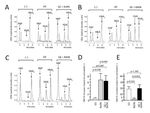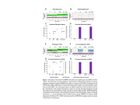Nuovo paragrafo
SCR Italy News
PROGRAMME !
Stem Cell Research Italy
XIII meeting
L'AQUILA
September 11-13, 2025
Submit your abstracts by June 15th, 2025, via the following link:
https://bleassociates.it/eventi/xiii-meeting-stem-cell-research-italy-531.html
Stem Cell Research Italy
XII meeting
PALERMO
June 13-15, 2024
Final Programme !
SCRI MEETING
Giovani ricercatori a confronto
Chieti 19/05/2023
One day Young Researchers meeting.
A dedicated day for Stem Cells projects of young researchers.
Grande successo!
Scarica QUI l'abstract book!
Scarica QUI il programma!
18
Young speakers
70
partecipanti registrati
JOBS
In questa pagina sono pubblicate le richieste di lavoro nel campo delle cellule staminali che ci pervengono
Data di pubblicazione sul sito: 11/01/2024
Descrizione/Job description: Post-Doctoral Position available as part of the ERA4Health CARDINNOV project: “Defining the ideal human Amniotic progenitor Secretome forMulation for future cArdioprotective paRacrine Therapy - AmnioSMART”(supervisor Prof. Sveva Bollini) at IRCCS Ospedale Policlinico San Martino, in Genova, Italy.
Salary Range:
Contract/Salary: The project is funded by the ERA4Health Partnership. The position is for
36 months starting in May 2024. The application and review processes are expected to be carried out in early spring 2024 with the interview of the selected Candidates at beginning of April 2024.
Aims of research:
The selected applicant will have the opportunity to work on the ambitious and interdisciplinary AmnioSMART project recently funded by the ERA4Health CARDINNOV programme and aiming at pin pointing the ideal secretome formulation ensuring medium-to-long-term cardioprotective paracrine effects via optimized delivery by smart biomaterials. The AmnioSMART project will unite internationally renowned Researchers from Italy, Portugal, Belgium and The Netherlands in an interdisciplinary yet synergic Consortium based on active and close collaborative relationship. The project will focus on a regenerative medicine and tissue engineering approach, combining stem cell-derived secretome biology with cutting-edge bioprinting, human induced pluripotent cell-technology, 3D modelling and spatial transcriptomics for precise administration of paracrine therapeutics.
The selected applicant will benefit from the dynamic environment of the labs within IRCCS Ospedale Policlinico San Martino area in central Genova, Italy. The research group has access to state-of-the-art equipment including cell culture facilities, time lapse-, transmission electron-, and 2-photon microscopy suites; advanced flow cytometry instruments (BD FACS Symphony S6), next generation sequencing facility (Illumina MiSeq and NextSeq 500 NGS platforms), MALDI imaging and ultimate CyTOF mass cytometry platforms.
Main activities: The Selected Candidate will design, conduct, analyze and interpret experiments. Self-motivation, critical thinking, problem solving skills and team-work attitude are highly important. The Selected Candidate should also possess good organizational and time management skills to ensure optimal collaboration with the project partners. Any previous experience in supervising undergraduate and PhD Students will be also valued.
Required qualification and skills: Applicants must hold a PhD degree in Regenerative Medicine, Biotechnology, Tissue Engineering or related scientific fields and have previous research experience in the field of cell biology and regenerative medicine. The necessary technical expertise includes hands-on experience in cellular and molecular biology techniques, potency assays and analysis of in vitro and ex-vivo preclinical disease models. Previous experience in: paracrine biology and cardiac regenerative medicine, in vitro 3D culture human stem cells, extracellular vesicles separation and concentration and cardiovascular disease models would be particularly appreciated. Fluent spoken and written English are required.
Information on the project:
Interested applicants should send a curriculum vitae, together with a brief statement of research interest, a publication list and the contact address of two referees to sveva.bollini@hsanmartino.it
PUBBLICAZIONI dei SOCI
In questa sezione sono pubblicati gli articoli scientifici dei soci di SCR Italy.
Protein a-Klotho in Human Adult Renal Progenitor Cells
Angela Picerno1, Francesca Giannuzzi1, Claudia Curci2, Giuseppe De Palma3, Mariagiovanna Di Chiano4, Simona Simone2, Rossana Franzin2,5, Anna Gallone4,5, Vito Francesco Di Lorenzo6, Alessandra Stasi2,5, Giovanni Battista Pertosa2,5, Carlo Sabbà1, Loreto Gesualdo2,5, Fabio Sallustio1,5,*,
1Department of Interdisciplinary Medicine, University of Bari Aldo Moro, Bari, Italy
2Nephrology, Dialysis and Transplantation Unit, DETO, University of Bari Aldo Moro, Bari, Italy
3Institutional BioBank, Experimental Oncology and Biobank Management Unit, IRCCS Istituto Tumori “Giovanni Paolo II”, Bari, Italy, Bari, Italy
4Department of Basic Medical Sciences, Neuroscience and Sense Organs, University of Bari Aldo Moro, Bari, Italy
5MIRROR-Medical Institute for Regeneration, Repairing and Organ Replacement, Interdepartmental Center, University of Bari Aldo Moro, Bari, Italy
6Urology Unit, IRCCS Istituto Tumori “Giovanni Paolo II”, Bari, Italy
*Corresponding author: Fabio Sallustio, PhD, Department of Interdisciplinary Medicine, University of Bari Aldo Moro, Piazza G. Cesare,11 70124 Bari, Italy.
Email: fabio.sallustio@uniba.it
Abstract
The long non-coding RNAs (lncRNA) play an important role in several biological processes, including some renal diseases. Nevertheless, little is known about lncRNA that are expressed in the healthy kidneys and involved in renal cell homeostasis and development, and even less is known about lncRNA involved in the maintenance of human adult renal stem/progenitor cells (ARPCs) that have been shown to be very important for renal homeostasis and repair processes. Through a whole-genome transcriptome screening, we found that the HOTAIR lncRNA is highly expressed in renal progenitors and potentially involved in cell cycle and senescence biological processes. By CRISPR/Cas9 genome editing, we generated HOTAIR knockout ARPC lines and established a key role of this lncRNA in ARPC self-renewal properties by sustaining their proliferative capacity and limiting the apoptotic process. Intriguingly, the HOTAIR knockout led to the ARPC senescence and to a significant decrease in the CD133 stem cell marker expression which is an inverse marker of ARPC senescence and can regulate renal
tubular repair after the damage. Furthermore, we found that ARPCs expressed high levels of the a-Klotho anti-aging protein and especially 2.6-fold higher levels compared to that secreted by renal proximal tubular cells (RPTECs). Finally, we showed that HOTAIR exerts its function
through the epigenetic silencing of the cell cycle inhibitor p15 inducing the trimethylation of the histone H3K27. Altogether, these results shed new light on the mechanisms of regulation of these important renal cells and may support the future development of precision therapies for
kidney diseases.
Domenico Aprile1, Nicola Alessio1, Tiziana Squillaro1, Giovanni Di Bernardo 1,2, Gianfranco Peluso3, Umberto Galderisi 1,2,4
1Department of Experimental Medicine,
Biotechnology and Molecular Biology Section,
University of Campania “Luigi Vanvitelli”,
Naples, Italy
2Sbarro Institute for Cancer Research and
Molecular Medicine, Center for Biotechnology,
Temple University, Philadelphia,
Pennsylvania, USA
3Faculty of Medicine and Surgery, Saint
Camillus International University of Health
Sciences, Rome, Italy
4Genome and Stem Cell Center (GENKOK),
Erciyes University, Kayseri, Turkey
Correspondence:
Umberto Galderisi, Department of
Experimental Medicine, Biotechnology and
Molecular Biology Section, University of
Campania “Luigi Vanvitelli”, Via Luigi De
Crecchio 7, Naples, Italy.
Email: umberto.galderisi@unicampania.it
Abstract
Objectives: Multilineage differentiating Stress Enduring (MUSE) cells are endogenous, stress-resistant stem cells, expressing pluripotency master genes and able to differentiate in cells of the three embryonic sheets. Stage-Specific Embryonic Antigen 3 (SSEA-3), a glycosphingolipid (GSL), is the marker for identifying MUSE cells and is used to isolate this population from mesenchymal stromal cells. GSLs modulate signal transduction by interacting with plasma membrane components. The growth factor FGF2, important for MUSE cells biology, may interact with GSLs. Specific cell surface markers represent an invaluable tool for stem cell isolation. Nonetheless their role, if any, in stem cell biology is poorly investigated. Functions of stem cells, however, depend on niche external cues, which reach cells through surface markers. We addressed the role of SSEA-3 in MUSE cell behaviour, trying to define whether SSEA-3 is just a marker or if it plays a functional role in this cell population by determining if it has any relationship with FGF2 activity.
Results: We evidenced how the SSEA-3 and FGF2 cooperation affected the self-renewal and clonogenic capacity of MUSE cells. The block of SSEA-3 significantly reduced the multilineage potential of MUSE cells with production of nullipotent clones.
Conclusions: We contributed to dissecting the mechanisms underlying MUSE cell properties for establishing successful stem-cell-based therapies and the promotion of MUSE cells as a tool for the in vitro disease model.
Lucia Carmela Cosenza 1, Cristina Zuccato 1,2, Matteo Zurlo 1 , Roberto Gambari 2,* and Alessia Finotti 1,2,*
1 Department of Life Sciences and Biotechnology, Section of Biochemistry and Molecular Biology,
University of Ferrara, 44121 Ferrara, Italy
2 Center ‘Chiara Gemmo and Elio Zago’ for the Research on Thalassemia, University of Ferrara,
44121 Ferrara, Italy
* Correspondence: gam@unife.it (R.G.); alessia.finotti@unife.it (A.F.); Tel.: +39-0532-974443 (R.G.);
+39-0532-974510 (A.F.)
In questo lavoro si dimostra che il Gene editing è una strategia efficace per correggere mutazioni genetiche in patologie quali la b-talassemia. Utilizzando il tool CRISPR-Cas9, gli autori hanno corretto la sequenza genica del gene mutato b39-globin, ottenendo una produzione de novo di emoglobina adulta (HbA).
Glutamine Availability Controls BCR/Abl Protein Expression
and Functional Phenotype of Chronic Myeloid Leukemia Cells
Endowed with Stem/Progenitor Cell Potential
Martina Poteti 1, Giulio Menegazzi 1,†, Silvia Peppicelli 1,† , Ignazia Tusa 1, Giulia Cheloni 1,2, Angela Silvano 1 ,
Caterina Mancini 1, Alessio Biagioni 1 , Alessandro Tubita 1, Nathalie M. Mazure 3, Matteo Lulli 1 ,
Elisabetta Rovida 1,* and Persio Dello Sbarba 1,*
1 Department of Experimental and Clinical Biomedical Sciences, University of Florence, Viale G.B. Morgagni 50,
50134 Firenze, Italy; martina.poteti@gmail.com (M.P.); g.menegazzi@student.unisi.it (G.M.);
silvia.peppicelli@unifi.it (S.P.); Ignazia.tusa@unifi.it (I.T.); gcheloni@bidmc.harvard.edu (G.C.);
angela.silvano@hotmail.it (A.S.); caterina.mancini1995@gmail.com (C.M.); alessio.biagioni@unifi.it (A.B.);
alessandro.tubita@unifi.it (A.T.); matteo.lulli@unifi.it (M.L.)
2 Beth Israel Deaconess Medical Center, Department of Medicine, Division of Genetics, Harvard University
Medical School, 330 Brookline Avenue, Boston, MA 02215, USA
3 Mediterranean Centre for Molecular Medicine-INSERM U1065, University of Nice-Sophia-Antipolis,
151 Route Saint Antoine de Ginestière, 06204 Nice, France; Nathalie.Mazure@unice.fr
* Correspondence: elisabetta.rovida@unifi.it (E.R.); persio@unifi.it (P.D.S.)
Abstract: This study was directed to characterize the role of glutamine in the modulation of the response of chronic myeloid leukemia (CML) cells to low oxygen, a main condition of hematopoietic stem cell niches of bone marrow. Cells were incubated in atmosphere at 0.2% oxygen in the absence or the presence of glutamine. The absence of glutamine markedly delayed glucose consumption, which had previously been shown to drive the suppression of BCR/Abl oncoprotein (but not of the fusion oncogene BCR/abl) in low oxygen. Glutamine availability thus emerged as a key regulator of the balance between the pools of BCR/Abl protein-expressing and -negative CML cells endowed with stem/progenitor cell potential and capable to stand extremely low oxygen. These findings were confirmed by the effects of the inhibitors of glucose or glutamine metabolism. The BCR/Abl-negative cell phenotype is the best candidate to sustain the treatment-resistant minimal residual disease (MRD) of CML because these cells are devoid of the molecular target of the BCR/Abl-active tyrosine kinase inhibitors (TKi) used for CML therapy. Therefore, the treatments capable of interfering with glutamine action may result in the reduction in the BCR/Abl-negative cell subset sustaining MRD and in the concomitant rescue of the TKi sensitivity of CML stem cell potential. The data obtained with glutaminase inhibitors seem to confirm this perspective.
Notizie dal Board
In questa sezione sono pubblicate le ultime notizie del consiglio direttivo della SCR Italy.
Scrivici usando il tasto apposito se vuoi proporre nuove iniziative al Consiglio direttivo!
Il Consiglio direttivo è lieto di annunciare che la SCR Italy è ora inserita nel Registro Unico Nazionale del Terzo Settore




